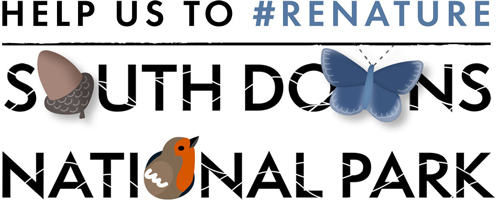Case study: Seaford Head Dew Pond Restoration
Background
There has been a pond on Seaford Head since approximately 1865.
After the establishment of the Local Nature Reserve in 1988 a proposal to restore the ‘disused dewpond’ was acted upon by the Management Committee and subsequently maintained up until 2010.
The dewpond had been relined in 1996, and fenced in 2002, but by 1998 non-native weeds (New Zealand Stonecrop and Parrot’s Feather) were invading strongly, having to be regularly removed. This work had last been undertaken in 2010 before the pond became neglected once more.
The Project
The proposal was suggested by Seaford Natural History Society in 2020, and developed with support from Seaford Town Council, who own the land, alongside advice from South Downs National Park Authority (SDNPA).
An Ecological Assessment to guide the work was funded by the Eastern Downs Area Ranger team with Tim Squire providing management advice.
This led to a grant application to the Volunteer Conservation Fund, which offers small grants administered through the South Downs National Park Trust.
The application was successful, and the first work party waded in, in May 2022.
The project focussed on maximising the biodiversity of the dewpond, and its benefit to wildlife.
A local volunteer group was established to extract and control the invasive weed, drying it pond-side and burning it, which was essential to avoid spread to other areas.
The edges of the pond have been revealed.
Rank, coarse grasses and bramble were cleared from the bank and a narrow surrounding path created.
As additional outcomes, two hibernacula were created as part of workshops with the conservation charity Froglife, to provide winter protection for reptiles and amphibians.
Throughout the course of the project, volunteers clocked up over 500 hrs of work during 10 work parties each month.
The grant of £3,690 was used to improve the surrounding fencing as well as buy tools, PPE and consumables for the volunteers.
it is so rewarding to have completed the project successfully, and in particular to see its on-going legacy, which will continue and expand on the original vision.
Paul Baker, Seaford Natural History Society
The Outcome
Almost half of the surface area is now open water, where none existed previously, providing fresh water for birds and grass snake.
The dewpond has been surveyed for wildlife species, accumulating a total, so far, of just over 200. This includes the rare Lesser Emperor Dragonfly nymph which is the first UK record of its breeding.
The volunteers have formed a Friends Group to continue pond management and further development which will extend the on-going benefits to local wildlife.
The Future
A huge amount of invasive weed has been removed, not without difficulty.
It would be impossible to remove completely and leaves the potential that it could recover quickly.
With support from the Seaford Natural History Society, volunteers formed a Friends Group who produced their own Development Plan for future renovation and management work at the pond.
This plan has now been accepted by Seaford Town Council who are the land owner.
For more information
Find out more about the Volunteer Conservation Fund: grants@southdowns.gov.uk
